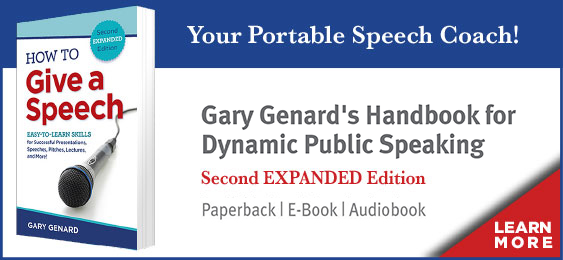
Have you heard the 'rules' about giving an effective speech? Here's how to resist by-the-numbers presentations that actually keep you from reaching your goal!
The other day, I read an article in a leading business journal that told me what my presentations should "always" be about. Last month, a communications expert informed me in a blog that I should always be disrupting my audience's point of view.
Then there are those endless reminders concerning the "rules" of using PowerPoint effectively.
Successful presentations are always about reaching listeners, not following rules. Turn your focus around from delivering information to connecting with and moving your audience. Learn the helpful ratio of time you spend on content vs. practicing your talks. Download my free Insights article, "Great Speaking? — It's About Performance Over Content!"
My friends, it's time we struck out for new territory.

Understanding Your Audience Is Your First Task
If you find yourself focusing on prescriptions like those instead of the people in the seats, you need to turn your thinking around. It’s part of an essential realization concerning public speaking: that it’s the speaker, not the data points, that makes the topic come alive and brings home its immediacy to an audience.
To make that happen, the speaker—paradoxically—must zero in first on the audience, rather than anything he or she will do in performance.
As a knowledge expert in your field, you could speak on your topic on a number of different levels. Much (I’m tempted to say “all”) depends on the demographics, sophistication, level of prior knowledge, intellectual and emotional needs, cultural considerations, and other factors concerning listeners. How can you know what you should be discussing to move this particular audience if you don’t understand who they really are and what they need?
Aiming to affect listeners the same way every time is a blunderbuss approach that's guaranteed to make you miss your mark by a mile. Instead, learn how vital it is to consider listeners' needs beforehand, and why you should conduct an audience analysis for a business presentation.

Beware of Prescriptions and "How It's Done Now"
It's natural for all of us to want to be part of the herd, in effect to hear the thunder of hooves all around us. Nowhere is this more true than in business, where the latest trend, buzzword (how many “buckets” do you place your customers in?) and insight is liable to start a stampede.
The idea that you always have to be disruptive in your presentations, for instance, or that you must start with pain points—even that you must always tell a story—belong with the antiquated advice that you should always open a business presentation with a joke. These are formulaic approaches that can result in clueless, by-the-numbers presentations. And as such, they can make you look bad.
Take the received wisdom that the future belongs to TED talks, that this is the way we will all speak from now on. This is sheer nonsense. TED talks are products, highly formulaic and fashioned for a particular audience (see my point above). A speaker stands in a red circle and speaks for 18 minutes, shows slides and discusses the ways he or she is changing how we view the world, through the very particular prism of the speaker's topic.
Some of these talks are revolutionary and powerful; most don't come close to that standard. At any rate, they are not the talks (or even the type of talks) you will be called upon at different times to give to educate, inspire, motivate, and activate your stakeholders.

Forget the Formulas that Will Turn You Into a Robot
Silliest of all are the formulas that place us in a presentation straightjacket: Your talk should be [this long], with [this many] PowerPoint slides. Each slide should have no more than [this number] of bullet points, and each bullet point should have [this many] words. Some of these prescriptions say we should spend a specific amount of time on each slide! Here instead are 3 key ways to influence your audience when you're using PowerPoint.
Yet one of the most fascinating talks-with-PowerPoint I ever saw, was a 90-minute presentation that used just six slides, each of which had only one word written on it. The way the speaker filled his 90 minutes with observations, case studies, audience participation, discussion, and personal experience was masterful. His talk owed nothing to any formula, and demonstrated in a brilliant light the centrality of the presenter—you in your own talks—in the speaking equation.
All public speaking is situational, depending upon a number of variables involved in preparation, practice, and performance. Consider the great speeches in history and you’ll always find a meeting of the speaker and the times when he or she spoke. Though the scale and the magnitude will be different for your speeches, the need is the same: to uncover the requirement of the moment and your ability to meet and fulfill it.
Your audience needs your hard work in thinking and preparing to make that happen in each specific instance. A one-size-fits-all approach just doesn't cut it.
You should follow me on Twitter here.



